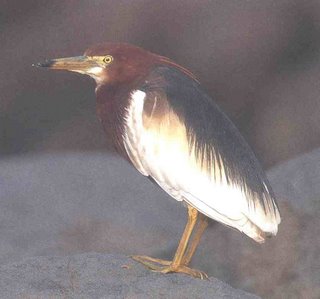THE DESECRATION OF HUAY TUNG TAO

Hill Blue Flycatcher by Yurie Ball
CHOP-CHOP, LET'S GET RID OF THIS GREENERY
(October 27th Mae Hia) Spotted a Crested Honey buzzard today, which isn’t unusual but this time it was a dark morph. They are so much easier to identify with their white underwing patch against a background of dark brown underparts. I don’t very often see this variation.
(October 28th. HTT) Another new bird for the area, a White-shouldered Starling, it’s not that common up here in the north, now 240 species for HTT. By road the area covers about five kilometres in all, forming a loop. One returnee also this morning, an Inornate Warbler. It’s lucky that I don’t suffer from a weak heart, I was walking through some fairly short grass and from right under my foot a Common snipe took off. A great whirring of wings and a grating call that comes across as scarrrp set my heart thumping. Normally they don’t wait that long to take off and we both usually suffer from just a mild surprise not a near coronary as was the case this time.
(October 30th Mae Hia) Another returnee today and it was also a new bird for the area, an Ashy Minivet, in fact it was a flock of 10+. Not seen too often by me up here in the north but maybe I’m just missing them. Caught a Ruddy-breasted Crake trying to sneak across a grassy track but when it realised the game was up it rushed the last few feet into a rice field. Birds do know when they have been spotted. Quite a few Eurasian Wrynecks around at the moment but I think they will soon scatter and find territories farther afield. Most of the Lesser Coucals I’m seeing now have donned their less showy winter plumage.
(October 31st HTT) And yet another returnee, an Eastern Marsh Harrier. It caused quite a stir as it quartered the rice fields putting up all sorts of birds. 7 or 8 Common snipe, 2 Green Sandpipers, some Zitting Cisticolas and the ubiquitous Chinese Pond Herons amongst them. A Hill Blue Flycatcher was also spotted, I don’t often see them this low, we are at about 350m above sea-level here in Chiang Mai.
A Grouse (more like the size of a Capercaillie) I should have realised there was something devious behind the building of that road at the top end of the lake at Huay Tung Tao. It wasn’t to save my tyres from puncturing on the rough track of yesterday as I naively thought. They have now brought in more heavy machinery and are hacking down anything that is green, undergrowth, bushes and trees. They have more or less completed an ATV (all terrain vehicle) circuit and paintball battleground and what little is left they are turning into camping sites. It’s like a disease creeping around the lake. So bang goes my favourite lowland birding site. I suppose that even a negative can be made positive and I am now looking forward to documenting the effect that these various activities will have on the bird-life – if there is any left by the time they finish.









